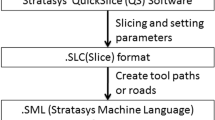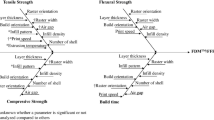Abstract
Fused filament fabrication (FFF) is a polymer extrusion-based additive manufacturing technique. In FFF process, semi-molten material is deposited in the form of strands and hence get bonded upon solidification through the formation of “neck”. These bonds play a crucial role in deciding the mechanical properties of FFF manufactured part. Bonding between the strands are governed by thermal energy (or in other words), a heating–cooling effect needs to be considered for the evaluation of FFF part mechanical properties. These are influenced by the FFF process parameters namely, extrusion temperature, layer thickness, part orientation, and raster orientation. This study attempts to develop a new mathematical model to establish a relationship between “neck radius” and “time” at different raster orientations. This paper explains the relationship between neck growth and raster orientations in FFF process. A new mathematical model has been developed by equating the work done by the surface tension and work done due to viscous forces by the molten polymer strands. From the developed mathematical model, the neck radius is evaluated with varying raster orientation (Ø°) (0 < Ø ≤ 900). The study also involves an experimental approach to establish the fact that neck growth (in the form of strength) is influenced by the FFF parameter settings the FFF parameter settings influence neck growth (in the form of strength). A face-centered design of experiment is considered, 30 experiments are performed and analyzed for responses like tensile strength, flexural strength, and volumetric shrinkage. Analysis of variance (ANOVA) is performed to validate statistical stability the proposed model. Response surface methodology is considered to study the interaction behavior of each FFF process parameters on each response parameters. From the developed mathematical model, the absolute neck growth at 30°, 45°, 60° and 90° raster orientations are obtained as 0.35 mm, 0.29 mm, 0.30 mm and 0.13 mm, respectively. The current study indicates the inverse relationship between neck growth and raster orientation. Study shows that mechanical properties highly depend on parameters that directly influence part orientation, raster orientation, and the extrusion temperature. Present study shows that higher mechanical properties can be achieved at lower raster and part orientation which is in greater agreement with the proposed mathematical model results.















Similar content being viewed by others
References
Butt J, Oxford P, Sadeghi S et al (2020) Hybrid manufacturing and mechanical characterization of Cu / PLA composites. Arab J Sci Eng. https://doi.org/10.1007/s13369-020-04778-y
Senthil P, Vinodh S, Jayanth N, Vidyapeetham AV (2017) A review on composite materials and process parameters optimisation for the fused deposition modelling process. Virtual Phys Prototyp. https://doi.org/10.1080/17452759.2016.1274490
Mohamed OA, Masood SH, Bhowmik JL (2015) Optimization of fused deposition modeling process parameters: a review of current research and future prospects. Adv Manuf 3:42–53. https://doi.org/10.1007/s40436-014-0097-7
Sheoran AJ, Kumar H (2019) Materials Today: Proceedings Fused Deposition modeling process parameters optimization and effect on mechanical properties and part quality: review and reflection on present research. Mater Today Proc. https://doi.org/10.1016/j.matpr.2019.11.296
Solomon IJ, Sevvel P, Gunasekaran J (2020) Materials Today: Proceedings A review on the various processing parameters in FDM. Mater Today Proc. https://doi.org/10.1016/j.matpr.2020.05.484
Valéry P (1945) Paul Valéry (1871–1945). 1:10–11
Es-Said OS, Foyos J, Noorani R et al (2000) Effect of layer orientation on mechanical properties of rapid prototyped samples. Mater Manuf Process 15:107–122. https://doi.org/10.1080/10426910008912976
Durgun I, Ertan R (2014) Experimental investigation of FDM process for improvement of mechanical properties and production cost. Rapid Prototyp J. https://doi.org/10.1108/RPJ-10-2012-0091
Wang CC, Lin TW, Hu SS (2007) Optimizing the rapid prototyping process by integrating the Taguchi method with the Gray relational analysis. Rapid Prototyp J 13:304–315. https://doi.org/10.1108/13552540710824814
Panda SK, Padhee S, Sood AK et al (2009) Optimization of Fused Deposition Modelling (FDM) process parameters using bacterial foraging technique. IIM. https://doi.org/10.4236/iim.2009.12014
Sood AK, Ohdar RK, Mahapatra SS (2015) Parametric appraisal of fused deposition modelling process using the grey Taguchi method. Proc Inst Mech Eng Part B J Eng Manuf 224:135–145. https://doi.org/10.1243/09544054JEM1565
Rankouhi B, Javadpour S, Delfanian F, Letcher T (2016) Failure analysis and mechanical characterization of 3D printed ABS with respect to layer thickness and orientation. J Fail Anal Prev 16:467–481. https://doi.org/10.1007/s11668-016-0113-2
Fernandez-Vicente M, Calle W, Ferrandiz S, Conejero A (2016) Effect of Infill Parameters on Tensile Mechanical Behavior in Desktop 3D Printing. 3D Print Addit Manuf 3:183–192. https://doi.org/10.1089/3dp.2015.0036
Nidagundi VB, Keshavamurthy R, Prakash CPS (2015) Studies on parametric optimization for fused deposition modelling process. Mater Today Proc 2:1691–1699. https://doi.org/10.1016/j.matpr.2015.07.097
Nuñez PJ, Rivas A, García-Plaza E et al (2015) Dimensional and surface texture characterization in fused deposition modelling (FDM) with ABS plus. Procedia Eng 132:856–863. https://doi.org/10.1016/j.proeng.2015.12.570
Penumakala PK, Santo J, Thomas A (2020) A critical review on the fused deposition modeling of thermoplastic polymer composites. Compos Part B 201:108336. https://doi.org/10.1016/j.compositesb.2020.108336
Gurrala PK, Regalla SP (2014) DOE based parametric study of volumetric change of FDM parts. Proc Mater Sci 6:354–360. https://doi.org/10.1080/00945719008048132
Sahu RK, Mahapatra SS, Sood AK (2013) A study on dimensional accuracy of fused deposition modeling (FDM) processed parts using fuzzy logic. J Manuf Sci Prod 13:183–197. https://doi.org/10.1515/jmsp-2013-0010
Senthil MSAP (2019) Homogenisation of elastic properties in FDM components using microscale RVE numerical analysis. J Brazilian Soc Mech Sci Eng. https://doi.org/10.1007/s40430-019-2037-8
Alafaghani A, Qattawi A, Alrawi B, Guzman A (2017) Experimental optimization of fused deposition modelling processing parameters: a design-for-manufacturing approach. Proc Manuf 10:791–803. https://doi.org/10.1016/j.promfg.2017.07.079
Bhalodi D, Zalavadiya K, Gurrala PK (2019) Influence of temperature on polymer parts manufactured by fused deposition modeling process. J Brazilian Soc Mech Sci Eng 41:1–11. https://doi.org/10.1007/s40430-019-1616-z
Compton BG, Post BK, Duty CE et al (2017) Thermal analysis of additive manufacturing of large-scale thermoplastic polymer composites. Addit Manuf 17:77–86. https://doi.org/10.1016/j.addma.2017.07.006
Costa SF, Duarte FM, Covas JA (2017) Estimation of filament temperature and adhesion development in fused deposition techniques. J Mater Process Technol 245:167–179. https://doi.org/10.1016/j.jmatprotec.2017.02.026
Yin J, Lu C, Fu J et al (2018) Interfacial bonding during multi-material fused deposition modeling (FDM) process due to inter-molecular diffusion. Mater Des 150:104–112. https://doi.org/10.1016/j.matdes.2018.04.029
Zhang J, Wang XZ, Yu WW, Deng YH (2017) Numerical investigation of the influence of process conditions on the temperature variation in fused deposition modeling. Mater Des 130:59–68. https://doi.org/10.1016/j.matdes.2017.05.040
Sun Q, Rizvi GM, Bellehumeur CT, Gu P (2008) Effect of processing conditions on the bonding quality of FDM polymer filaments. Rapid Prototyp J 14:72–80. https://doi.org/10.1108/13552540810862028
Li L, Sun Q, Bellehumeur C, Gu P (2002) 26 Investigation of bond formation in FDM process. Solid Free Fabr Proc. https://doi.org/10.1108/13552540810862028
Zhang Y, Chou Y (2006) Three-dimensional finite element analysis simulations of the fused deposition modelling process. Proc Inst Mech Eng Part B J Eng Manuf 220:1663–1671. https://doi.org/10.1243/09544054JEM572
Taylor P, Gurrala PK, Regalla SP (2014) Virtual and Physical Prototyping Part strength evolution with bonding between filaments in fused deposition modelling Part strength evolution with bonding between filaments in fused deposition modelling This paper studies how coalescence of filaments cont. Virtual Phys Prototyp. https://doi.org/10.1080/17452759.2014.913400
Pokluda O, Bellehumeur CT, Vlachopoulos J (1997) Modification of Frenkel’s model for sintering. AIChE J 43:3253–3256. https://doi.org/10.1002/aic.690431213
Gurrala PK, Regalla SP (2014) Multi-objective optimisation of strength and volumetric shrinkage of FDM parts: a multi-objective optimization scheme is used to optimize the strength and volumetric shrinkage of FDM parts considering different process parameters. Virtual Phys Prototyp 9:127–138. https://doi.org/10.1080/17452759.2014.898851
Singh D, Singh R, Boparai KS (2020) Investigations on hardness of investment-casted implants fabricated after vapour smoothing of FDM replicas. J Brazilian Soc Mech Sci Eng. https://doi.org/10.1007/s40430-020-2265-y
Korkut V, Yavuz H (2020) Enhancing the tensile properties with minimal mass variation by revealing the effects of parameters in fused filament fabrication process. J Brazilian Soc Mech Sci Eng. https://doi.org/10.1007/s40430-020-02610-0
Costa SF, Duarte FM, Covas JA (2015) Thermal conditions affecting heat transfer in FDM/FFE: a contribution towards the numerical modelling of the process: this paper investigates convection, conduction and radiation phenomena in the filament deposition process. Virtual Phys Prototyp 10:35–46. https://doi.org/10.1080/17452759.2014.984042
Author information
Authors and Affiliations
Corresponding author
Ethics declarations
Conflict of interest
The author declare that they have no known competing financial interests or personal relationships that could have appeared to influence the work reported in this paper.
Additional information
Technical Editor: Zilda de Castro Silveira.
Publisher's Note
Springer Nature remains neutral with regard to jurisdictional claims in published maps and institutional affiliations.
Rights and permissions
About this article
Cite this article
Trivedi, A., Gurrala, P.K. Investigations on the effect of orientations on mechanical properties in fused filament fabrication parts using numerical model. J Braz. Soc. Mech. Sci. Eng. 44, 145 (2022). https://doi.org/10.1007/s40430-022-03422-0
Received:
Accepted:
Published:
DOI: https://doi.org/10.1007/s40430-022-03422-0




